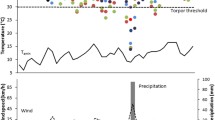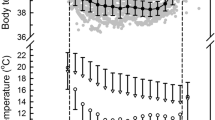Abstract
Most studies on animal physiology and behaviour are conducted in captivity without verification that data are representative of free-ranging animals. We provide the first quantitative comparison of daily torpor, thermal biology and activity patterns, conducted on two groups of sugar gliders (Petaurus breviceps, Marsupialia) exposed to similar thermal conditions, one in captivity and the other in the field. Our study shows that activity in captive gliders in an outdoor aviary is restricted to the night and largely unaffected by weather, whereas free-ranging gliders omit foraging on cold/wet nights and may also forage in the afternoon. Torpor occurrence in gliders was significantly lower in captivity (8.4% after food deprivation; 1.1% for all observations) than in the field (25.9%), mean torpor bout duration was shorter in captivity (6.9 h) than in the field (13.1 h), and mean body temperatures during torpor were higher in captivity (25.3°C) than in the field (19.6°C). Moreover, normothermic body temperature as a function of air temperature differed between captive and free-ranging gliders, with a >3°C difference at low air temperatures. Our comparison shows that activity patterns, thermal physiology, use of torpor and patterns of torpor may differ substantially between the laboratory and field, and provides further evidence that functional and behavioural data on captive individuals may not necessarily be representative of those living in the wild.




Similar content being viewed by others
Abbreviations
- T a :
-
Air temperature
- T b :
-
Body temperature
- T skin :
-
Skin temperature
References
Barnes BM, Carey HV (eds) (2004) Life in the cold: evolution, mechanisms, adaptation, and application. In: 12th international hibernation symposium. Biological Papers of the University of Alaska #27. Inst. Arctic Biology, University of Alaska, Fairbanks
Brigham RM, Körtner G, Maddocks TA, Geiser F (2000) Seasonal use of torpor by free-ranging Australian owlet-nightjars (Aegotheles cristatus). Physiol Biochem Zool 73:613–620
Chruszcz BJ, Barclay RMR (2002) Thermoregulatory ecology of a solitary bat, Myotis evotis, roosting in rock crevices. Func Ecol 16:18–26
Cooper CE, Withers PC (2004) Patterns of body temperature variation and torpor in the numbat, Myrmecobius fasciatus (Marsupialia: Myrmecobiidae). J Therm Biol 29:277–284
Costa DP, Sinervo B (2004) Field physiology: physiological insights from animals in nature. Annu Rev Physiol 66:209–238
Dausmann KH (2005) Measuring body temperature in the field—evaluation of external vs. implanted transmitters in a small mammal. J Therm Biol 30:195–202
Fleming MR (1980) Thermoregulation and torpor in the sugar glider, Petaurus breviceps (Marsupialia: Petauridae). Aust J Zool 28:521–534
Geiser F (2004) Metabolic rate and body temperature reduction during hibernation and daily torpor. Annu Rev Physiol 66:239–274
Geiser F, Ferguson C (2001) Intraspecific differences in behaviour and physiology: effects of captive breeding in feathertail gliders. J Comp Physiol B 171:569–576
Geiser F, Körtner G (2004) Thermal biology, energetics and torpor in the possums and gliders. In: Goldingay RL, Jackson SM (eds) The biology of Australian possums and gliders. Surrey Beatty, Sydney, pp 186–198
Geiser F, Ruf T (1995) Hibernation versus daily torpor in mammals and birds: physiological variables and classification of torpor patterns. Physiol Zool 68:935–966
Geiser F, Holloway JC, Körtner G, Maddocks TA, Turbill C, Brigham RM (2000) Do patterns of torpor differ between free-ranging and captive mammals and birds? In: Heldmaier G, Klingenspor M (eds) Life in the cold: 11th international hibernation symposium. Springer, Berlin, pp 95–102
Geiser F, Goodship N, Pavey CR (2002) Was basking important in the evolution of mammalian endothermy? Naturwissenschaften 89:412–414
Grigg GC, Augee ML, Beard LA (1992) Thermal relations of free-living echidnas during activity and in hibernation in a cold climate. In: Augee ML (ed) Platypus and echidnas. Royal Zool Soc NSW, Sydney pp 160–173
Hiebert SM (1990) Energy costs and temporal organization of torpor in the rufous hummingbird (Selasphorus rufus). Physiol Zool 63:1082–1097
Holloway JC, Geiser F (1996) Reproductive status and torpor of the marsupial Sminthopsis crassicaudata: effects of photoperiod. J Therm Biol 21:375–380
Holloway JC, Geiser F (2001) Seasonal changes in the thermoenergetics of the marsupial sugar glider, Petaurus breviceps. J Comp Physiol B 171:643–650
Hudson JW, Scott IM (1979) Daily torpor in the laboratory mouse Mus musculus var. albino. Physiol Zool 52:205–218
Hume ID (1999) Marsupial nutrition. Cambridge University Press, Cambridge
Körtner G, Geiser F (1995) Body temperature rhythms and activity in reproductive Antechinus (Marsupialia). Physiol Behav 58:31–36
Körtner G, Geiser F (2000a) Torpor and activity patterns in free-ranging sugar gliders Petaurus breviceps (Marsupialia). Oecologia 123:350–357
Körtner G, Geiser F (2000b) The temporal organization of daily torpor and hibernation: circadian and circannual rhythms. Chronobiol Int 17:103–128
Körtner G, Brigham RM, Geiser F (2000) Winter torpor in a large bird. Nature 407:318
Lovegrove BG, Körtner G, Geiser F (1999) The energetic costs of arousal from torpor in the marsupial Sminthopsis macroura: benefits of summer ambient temperature cycles. J Comp Physiol B 169:11–18
Mzilikazi N, Lovegrove BG (2002) Reproductive activity influences thermoregulation and torpor in pouched mice, Saccostomus campestris. J Comp Physiol B 172:7–16
McNab BK, Bonaccorso FJ (2001) The metabolism of New Guinean pteropodid bats. J Comp Physiol B 171:201–214
Nicol S, Andersen NA (2000) Patterns of hibernation of echidnas in Tasmania. In: Heldmaier G and Klingenspor M (eds), Life in the cold. 11th international hibernation symposium. Springer, Heidelberg pp 21–28
Schmid J (2000) Daily torpor in the grey mouse lemur (Microcebus murinus) in Madagascar: energetic consequences and biological significance. Oecologia 123:175–183
Smith AP, Winter J (1984) A key and field guide to the Australian possums, gliders and koala. In: Smith AP, Hume ID (eds) Possums and gliders. Australian mammal society and surrey beatty and sons, Chipping Norton, Australia, pp 579–594
Wang LCH (1978) Energetics and field aspects of mammalian torpor: the Richardsons’s ground squirrel. In: Wang LCH, Hudson JW (eds) Strategies in cold. Academic Press, New York, pp 109–145
Wang LCH (1989) Ecological, physiological, and biochemical aspects of torpor in mammals and birds. In: Wang LCH (ed) Animal adaptation to cold. Springer, Berlin pp 361–401
Willis CKR, Brigham RM, Geiser F (2006) Deep, prolonged torpor by pregnant, free-ranging bats. Naturwissenschaften 93:80–83
Withers PC (1992) Comparative animal physiology. Saunders, Fort Worth
Acknowledgments
We thank Chris Pavey and Craig Willis for constructive comments on the manuscript. The work was supported by a grant from the Australian Research Council to FG. The UNE Animal Ethics Committee and the National Parks and Wildlife Service of NSW approved experiments.
Author information
Authors and Affiliations
Corresponding author
Additional information
Communicated by I.D. Hume.
Rights and permissions
About this article
Cite this article
Geiser, F., Holloway, J.C. & Körtner, G. Thermal biology, torpor and behaviour in sugar gliders: a laboratory-field comparison. J Comp Physiol B 177, 495–501 (2007). https://doi.org/10.1007/s00360-007-0147-6
Received:
Revised:
Accepted:
Published:
Issue Date:
DOI: https://doi.org/10.1007/s00360-007-0147-6




